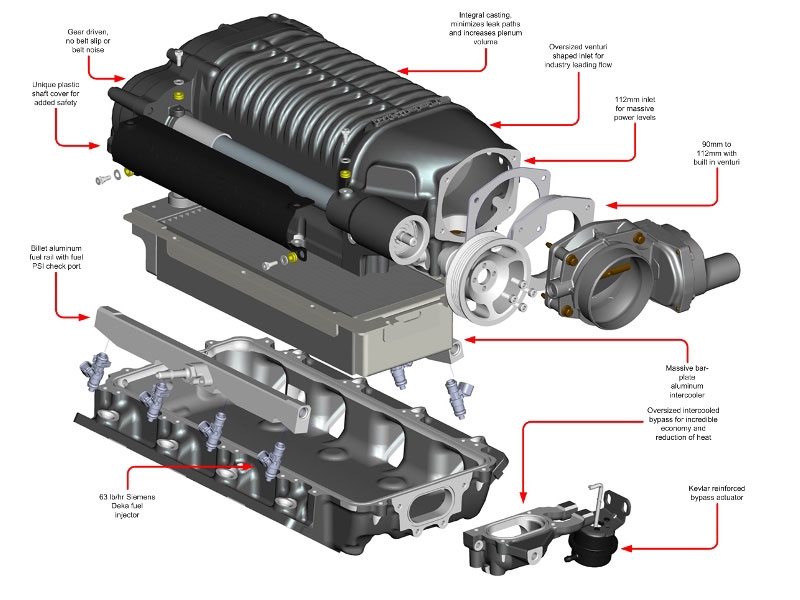
Los sobrealimentadores son básicamente compresores/sopladores que toman aire a presión ambiental normal, lo comprimen y lo empujan con fuerza hacia el motor. La potencia al compresor/soplador se transmite desde el motor a través de la transmisión por correa.
La adición de una cantidad adicional de mezcla de aire y combustible al cilindro aumenta la presión media efectiva del motor. Un incremento en MEP hace que el motor produzca más potencia. De esta forma, añadir un compresor al motor lo hace más eficiente.
TIPOS DE SOBRECARGADOR
Existen principalmente dos tipos de sobrealimentadores. El primero se conoce como sobrealimentador de desplazamiento positivo y el otro se conoce como sobrealimentador dinámico. La diferencia básica entre ambos es que el sobrealimentador de desplazamiento positivo mantiene un nivel constante de presión en todas las velocidades del motor, mientras que el sobrealimentador dinámico proporciona una presión cada vez mayor a medida que aumenta la velocidad. Esta es la diferencia fundamental básica entre ellos. Estos supercargadores se subdividen como se indica a continuación.
- SOBRECARGADOR DE DESPLAZAMIENTO POSITIVO:
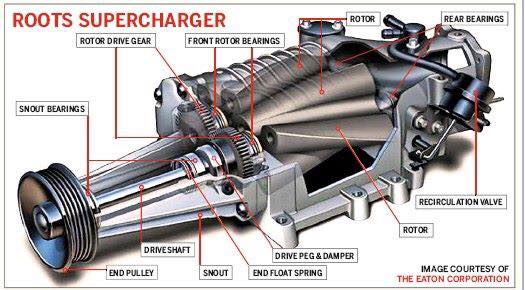
Como comentamos en la sección anterior, estos supercargadores entregan el mismo volumen de carga a cualquier velocidad del motor o estos supercargadores no dependen de la velocidad del motor. Los principales tipos de sobrealimentadores de desplazamiento positivo son los de raíz y los de doble tornillo.
- Estilo raíz
Este diseño tiene dos rotores especialmente diseñados que giran en direcciones opuestas (uno en el sentido de las agujas del reloj y el otro en el sentido contrario a las agujas del reloj) para comprimir el aire. Según el diseño del rotor, este sobrealimentador se subdivide en dos tipos: rotor de dos lóbulos, rotor de tres lóbulos, rotor de cuatro lóbulos, etc. A medida que el rotor gira, atrapan el aire mediante estos lóbulos que vienen del lado de succión o del puerto de entrada y lo fuerzan hacia la descarga. puerto lateral o de salida. La cantidad de aire comprimido es independiente de la velocidad del motor y cada vez este sobrealimentador comprime la misma cantidad de aire.
- Ventajas:
- Diseño sencillo
- Más adecuado con motor de alta velocidad
Desventajas:
- Flujo de aire pulsante a baja velocidad.
- Menos eficiencia.
- Pesado.
- Crean mucho calor debido a la fricción.
- Fuga trasera a baja velocidad.
- Proporcione la misma cantidad de aire a RPM bajas y altas.
Sobrealimentador de doble tornillo
Como su nombre lo indica, este tipo de sobrealimentador tiene dos tornillos que giran en diferentes direcciones. Uno de los tornillos gira en el sentido de las agujas del reloj y el otro en el sentido contrario a las agujas del reloj. El funcionamiento de este sobrealimentador es el mismo que el del tipo raíz. También aspira aire de un lado y lo entrega al puerto de salida. Este dispositivo proporciona un flujo de aire más suave en comparación con el estilo raíz.
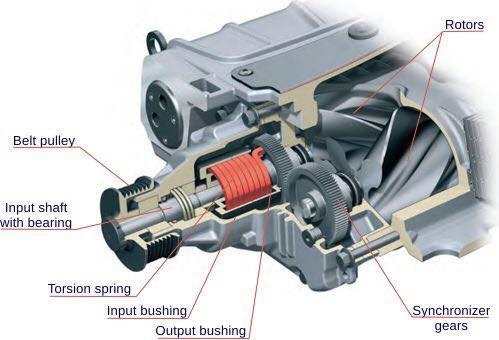
Ventajas:
- No hay problema de fuga trasera.
- Proporcionar un flujo de aire más suave.
Desventajas:
- Alta generación de calor debido a la fricción.
- Ruidoso en funcionamiento.
Sobrealimentador tipo paleta
Varias paletas están montadas en el tambor del sobrealimentador. Estas paletas se empujan hacia afuera mediante resortes precomprimidos. Esta disposición ayuda a que la paleta permanezca en contacto con la superficie interior del cuerpo.
Ahora, debido a la rotación excéntrica, el espacio entre dos paletas es mayor en la entrada y menor en la salida. De esta forma, la cantidad de aire que entra por la entrada disminuye su volumen en su camino hacia la salida. Una disminución del volumen da como resultado un aumento de la presión del aire. Así, la mezcla obtenida a la salida está a mayor presión que a la entrada.
SOBRECARGADOR DINÁMICO:
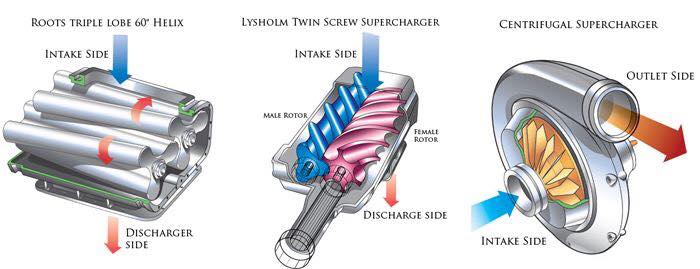
Como comentamos anteriormente, este tipo de sobrealimentador aumenta la presión del aire a medida que aumenta la velocidad del motor. El efecto de sobrealimentación en este tipo depende en gran medida de la velocidad del motor. También se subdividió en los siguientes tipos.
Tipo centrífugo
Como su nombre lo indica, este tipo utiliza fuerza centrífuga para comprimir el aire. El diseño de este sobrealimentador es el mismo que el del compresor centrífugo. Tiene un impulsor que está conectado con el cigüeñal mediante una transmisión por correa. Cuando el motor gira, hace girar el impulsor que aspira el aire de un lado. Sobre este aire actúa la acción centrífuga que aumenta su energía cinética y la entrega a un difusor. El aire que entra en la difusión tiene alta velocidad a baja presión. El difusor convierte este aire de baja presión y alta velocidad en aire a alta presión y baja velocidad. Este aire a alta presión luego se envía al motor.
Ventajas:
Es de tamaño pequeño.
Alta eficiencia.
Desventajas:
La cantidad de aire no es fija.
- Onda de presión
- flujo axial
MÉTODOS DE SOBRECARGACIÓN
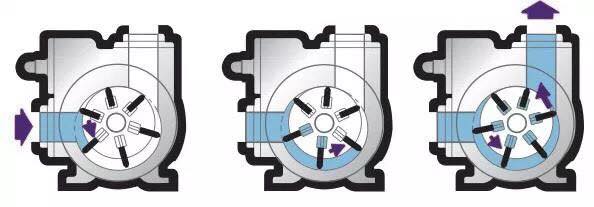
Hay otras formas de forzar el aire que no necesitan potencia adicional a diferencia de los compresores. Los 2 más utilizados son:
- Sobrealimentación por efecto Ram
En este caso, el colector de admisión está diseñado de tal manera que el aire ingresa automáticamente al cilindro. ¡El aire intenta entrar continuamente en el cilindro pero las válvulas de admisión se abren y cierran varias veces por segundo! Cada vez que la válvula se cierra, el aire simplemente choca contra ella. Esto genera una onda de presión que viaja en la dirección opuesta hasta que golpea el pleno y se refleja.
Ahora bien, si la frecuencia de resonancia del pleno y del motor coincide, esta onda de presión transporta más aire al cilindro haciendo el trabajo de un sobrealimentador.
- Sobrealimentación bajo pistón –
Este tipo de método se adopta generalmente en grandes motores marinos. Utiliza la parte inferior del pistón para comprimir el aire. Con la sincronización adecuada de las válvulas, este sistema proporciona un suministro adecuado de aire comprimido, ya que hay 2 carreras de suministro por cada carrera de succión de cada carrera.
VENTAJAS Y DESVENTAJAS DEL SUPERCARGADOR
Ventajas de la sobrealimentación
- Mayor potencia de salida
- Mayor inducción de masa de carga.
- Mejor atomización del combustible
- Mejor mezcla de combustible y aire.
- Mejores productos de eliminación
- Mejores características de par en todo el rango
- Aceleración rápida del vehículo.
- Combustión completa y suave
- Incluso se puede utilizar combustible con mala calidad de ignición.
- Arranque en frío mejorado
- Reducción del humo de escape
- Reducción del consumo específico de combustible.
- Mayor eficiencia mecánica.
- Funcionamiento suave y reducción de la tendencia a la detonación del diésel.
Desventajas de la sobrealimentación
- Mayor tendencia a la detonación en motores SI.
- Aumento del estrés térmico
- Mayor pérdida de calor debido al aumento de la turbulencia.
- Mayor carga de gas
- Mayores requisitos de refrigeración del motor.

este es un piesa muy esencial para los motores de velocidad o de carreras el cual es pequeño y el diseño es sencillo pero el flujo de aire pulsante a baja velocidad el cual tiene menor eficiencia o mas bien pesado el genera mucho calor debido a la fricción en el cual crea fugas traseras y baja velocidad en el cual proporcione la misma cantidad de aire a bajas y altas RPM
SALUDOS